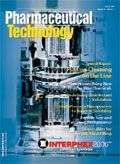Characterization, Qualification, and Validation of a Disposable Final Filling Process for Parenteral and Ophthalmic Drugs
Because of the growing popularity of single-use materials, the identification, characterization, and qualification of new materials used for disposable processes have become increasingly important for both regulatory and production purposes. This article describes one approach to identifying and validating the materials used in a disposable filling process.
Many articles describe the growing need for and benefits of the replacement of traditional, reusable technologies with disposable, single-use components in the pharmaceutical and biotechnology industries (1–6). Replacing reusable materials (e.g., stainless steel) with disposable products is cost effective and increases operator and product safety (3–6).
For disposable technologies to be accepted by an industry, vendors must show that disposable systems can have equal or better performance than traditional systems. As vendors begin supplying complete sterile, disposable solutions to the pharmaceutical and biotechnology industries, suppliers will be required to have complete validation packages and an in-depth understanding of their products.
The first decision that must be made when designing and manufacturing a disposable assembly is the choice of materials to be used. The materials typically chosen are polymeric materials that must be sterilized using common sterilization methods. Typically, prepackaged, presterilized disposable assemblies are gamma irradiated at >25 kGy. Therefore, the materials of these assemblies must be nontoxic and resist changes to their physical properties after being irradiated.
Once the materials are chosen, bioburden (i.e., the level of contamination) must be minimized during the assembly process. Low levels of bioburden are required throughout the product fluid path to ensure endotoxin levels are well below accepted levels. Overall bioburden levels for inner and outer material surfaces also must be monitored carefully and maintained during the manufacture of the disposable modules to ensure the validity of the subsequent sterilization process.
Validated and guaranteed product sterility is the most critical parameter for disposable systems in final fill and finish. Manufacturers of disposable products that are intended for a Class 100 environment or better must prove sterility throughout the fluid path as well as on the products' outer surfaces.
The validation method must then show that the disposable process is reliable, robust, and safe. The final filling performance of the disposable system must be validated and qualified to show repeatability and robustness. The levels of extractables and particulates for the chosen materials must be quantified, and the major contributing components must be identified. In addition, it must be proven that the final packaged assemblies maintain sterility and integrity during storage.
The final test for any disposable product is to show that it maintains product sterility during actual operating conditions. In the case of final fill and finish, the last step in the process validation is to perform media trials in which the final filling process is interrupted by process interventions while media are dispensed, packaged, and tested for sterility.
The following sections present details and results of the validation of a disposable filling system. All media fills were performed at St. Jude Children's Research Hospital (Memphis, TN). The system validated was the Acerta DS1 dispensing system (Millipore Corporation, Billerica, MA), and its disposable module used to perform the media fill is described. Figure 1 shows the dispensing system with a disposable module installed. The module consists of tubing, connectors, a reservoir, and a needle, all of which are disposable.
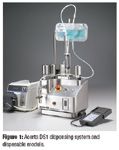
Figure 1
Methods, results, and discussion
Biological validation. The choice of materials to use is the first critical step in providing a robust, sterile product. As described in the "Performance validation" section that follows, none of the materials chosen should show significant physical degradation after gamma irradiation. Because the materials used for the disposable assemblies are polymeric, they must conform to safety standards for plastics set forth by the United States, European, and Japanese Pharmacopeias. To ensure this, each material that may come into contact with the drug product must pass United States Pharmacopeia (USP) 27 ‹88› "Biological Reactivity Tests In Vivo" after the samples are gamma irradiated to >40 kGy, the maximum dosage level that the disposable product may experience.
After gamma irradiation, endotoxin levels must be measured for the entire disposable assembly using methods described in USP ‹85› "Bacterial Endotoxins Test." The detected levels must remain below 0.25 endotoxin units per milliliter (EU/mL).
Sterility validation. Medical device manufacturers use standard methods to show their products' sterility, and these methods also have been used with disposable assemblies (1). Because of the relatively small lot sizes for the disposable modules, two methods, either VDmax (7) or AAMI/ISO 13409 (8) could be followed to ensure sterility. Because of infrequent lot manufacture, the AAMI/ISO 13409 method was chosen for these disposable modules. To prove the modules were exposed to a minimum sterilization dose of 25 kGy, all lots of disposable modules were subjected to the dose verification experiment. The next two consecutive lots manufactured were tested using the same procedure as the first lot, and quarterly audits followed to ensure bioburden levels, process robustness, and sterility. To obtain the worst-case scenario, disposable modules with the maximum surface area were used in the validation testing.
The average module bioburden for the inner and outer surfaces must remain less than 1000 cfu to allow AAMI/ISO 13409 to be used. After modules were assembled and packaged, but before gamma irradiation, 10 units were sent to an outside laboratory to determine the average inherent bioburden according to ANSI/AAMI/ISO 11737-1. Using the determined average inherent bioburden, a verification dose was calculated, which is typically below 10 kGy. This verification dose level was used to demonstrate that disposable modules gamma irradiated at 25 kGy or higher provide a sterility assurance level (SAL) of 106. On the basis of the lot size, 20 disposable modules were sterilized at the minimum dose level and tested for sterility in accordance with AAMI/ISO 11737-2 (9) at an outside laboratory. Assurance that 25 kGy will provide a sterile product requires that not more than one positive sterility test sample be observed for the verification dose experiments. All of the disposable filling modules tested showed no growth.
Performance validation. A critical component of disposable module validation is showing the repeatability and robustness of the disposable dispensing system after gamma irradiation at 40–50 kGy. This level of irradiation guarantees that the tested product has been exposed to the maximum amount of radiation that it may encounter under its standard irradiation process. Figures 2a and 2b show results of tests performed during a four-hour period. The disposable dispensing system was continuously operated at the fill rates indicated on the figures for the entire four hours, and dispense-weight measurements periodically were recorded. The criteria for validation were that three standard deviations of the data be <5 mg for dispense target weights <1 g and <0.5% for all dispense target weights >1 g. The horizontal orange lines on the graphs represent ±5 mg deviations above and below the target value of 0.200 g for Figure 2a and ±0.5% deviations above and below the target value of 2.500 g for Figure 2b. The horizontal dashed lines on the graphs indicate the times at which the system was retargeted without being stopped. This was done, even if the data were not drifting, to validate that retargeting would not adversely affect the dispense repeatability.

Figure 2
In addition to conducting performance testing, the reliability of the disposable modules must be validated. Each module was checked for leaks using a hydrogen leak-detection system before packaging. To pass the hydrogen leak test, the module must have a gas flow rate lower than a set value that corresponds to a known orifice size. In addition, although this is a low-pressure (<0.5 psig) system, as a level of assurance, two disposable modules from each of four separate lots were pressurized for 8 h at 3 psi. Two additional disposable modules from each of four separate lots were pressurized for 1 h at 8 psi. All of the modules then were tested for integrity using the hydrogen leak-detection system. All modules passed the leak test. As a final test, three modules from each of the three lots were pressurized until they burst, thereby showing that the tubing would stay connected, the film would not burst, and the reservoir seams would not rupture at pressures <10 psig for up to 1 min (see Table I).

Table I: Pressure at which disposable modules burst.
Extractables validation. The next step was to quantify the level of any compounds that might be extracted from the fluid contact materials, specifically after they have undergone gamma irradiation. Again, a gamma irradiation >40 kGy was used as a worst case. First, each component used in the disposable assembly was extracted individually, thereby allowing for the identification of the "dirty" components (i.e., those that were contributing most to the total extractables level). To quantify the amount of organic material that was extracted, total organic carbon (TOC) analyzers were used. The length of time that the materials were allowed to soak, along with other factors such as temperature and extracting solution, determined the amount of material that was extracted. Figure 3 shows the TOC results for multiple components extracted using three different model solutions.

Figure 3
Analytical techniques that can identify a specific "fingerprint" for each component extracted are available. This fingerprint then can be used to find the origin of the extractables from the entire assembly. Each of the extracted species can be identified using methods such as high-performance liquid chromatography, Fourier transform infrared spectroscopy, liquid chromatography–mass spectrometry, gas chromatography–mass spectrometry, or any combination of these methods. Although the process can be time consuming and difficult, it can greatly facilitate leachables identification in the final drug products.
After materials were chosen for the disposable module, the final disposable module was tested for extractables. Because disposables of different sizes contain different amounts of each material, multiple lots that cover the range of sizes available needed to be tested. The modules with the dirtiest material, which were identified during the individual component tests, were expected to have the highest levels of extractables. In addition, as previously mentioned, the length of time that the solution remained in the disposable was critical in determining the level of extractables. Figures 4a and 4b show the results of 5- and 60-min static soaks, respectively, and extraction results from pre- and postgamma-irradiation modules. These two figures show higher TOC levels resulting from longer extraction times and gamma irradiation. These results were expected because the degradation of polymeric material, even if only slight, and the longer extraction time allowed more material to migrate into the test fluid. The higher TOC levels for disposable module #500 result from the greater presence of a dirty component, Tubing C in Figure 3.
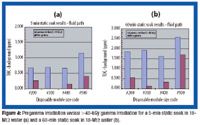
Figure 4
One aspect of the extractables profile that is most important to a pharmaceutical manufacturer is the amount of contaminate being leached into the final product. To minimize contaminant leachage, the disposable modules must be tested in a dynamic situation in addition to being tested in the static conditions described previously. The disposable modules were installed and run using a model fluid, 18-MΩ water in this case. The filling system was turned on, and dispenses were collected periodically. Because of minimum sample-volume limitations on the analytical instruments, and depending on the dispense volume, multiple dispenses were collected in the same container, resulting in an average TOC count for all of the samples collected. Figure 5 shows the results for different lengths of time that the liquid was allowed to sit before dispensing was started. As would be expected from the static soak testing, the longer the fluid stayed in the module, the higher the starting extractable levels. After one hour of running, the dispense system was shut down for various lengths of time and then restarted. Again, the longer the shut-down period, the higher the starting extractable levels. The former levels, however, were not nearly as high as the initial starting values.
Quantifying the extractables using a model fluid such as water is a good first step, but the leachables for a specific drug product may be higher or lower than the model fluid, depending on the drug's composition. To get an exact leachables profile, each drug should be tested under the same conditions as those described in the manufacturing standard operating procedures (SOPs). As previously described, the extractables, and subsequently the leachables, level can be minimized by reducing the length of time that the fluid sits in contact with the disposable components (see Figure 5). Depending on the individual drug requirements, this may dictate set-up procedures and the length of time the system may sit idle before purging is required.
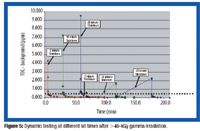
Figure 5
Particulate validation. To quantify the number of particles the dispensing system could generate, the process that had the greatest potential to generate particles was identified. The peristaltic pump that delivered fluid to the disposable module was found to be the point at which the most particles could be created. Because the peristaltic pump used with the Acerta DS1 dispense system is on only intermittently, to test the worst-case scenario, a section of tubing, the same type used for the disposable model feed tubing, was placed in the peristaltic pump, and solution was circulated through the tubing continuously (see Figure 6).
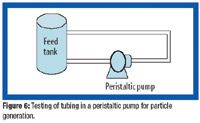
Figure 6
Figures 7a–c show the number of particles >5 μm, >10 μm, and >25 μm, respectively, for samples taken from the solution feed tank at 0, 1, 2, 4, and 8 h for three test solutions: H2O (pH ≈ 6.5), HCl (pH ≈ 2.0), and NaOH (pH ≈ 12.0). The zero-time samples were taken before the experiments were conducted. Samples taken after the initial sample showed cumulative particle levels over 1, 2, 4, and 8 h, which correspond to circulating 12.6, 25.2, 50.4, and 100.8 L through the tubing, respectively. All of the particle levels shown in Figure 7 were well below the USP 27 ‹788› required particle levels.

Figure 7
The level of particulates in the final product is a real concern for drug producers, as is the level of extractables. Samples must be taken over time to quantify the number of particles that may be produced during the filling process. For example, Figure 8 shows the number of particles minus background (the particle levels in the feed to the dispensing system) collected at various times during 8 h of continuously dispensing water. These tests can help determine whether the dispensing system was generating particles or whether the disposable module contained particles before being installed. For the example shown in Figure 8, the highest particle levels were at time T = 0, most likely a result of particle presence in the disposable module before starting the system. Once these particles were removed, after T = 0, the particles present most likely resulted from the peristaltic pump and pinch valves acting on the disposable module.

Figure 8
Shelf life validation. The purpose of shelf life testing is to validate that the disposable modules do not degrade over time. Samples of packaged disposable modules from multiple lots were taken and stored at room temperature for a given period of time. This process is referred to as real-time testing. Additional testing was conducted by taking samples from various lots and subjecting them to extreme conditions, such as 60 °C and 60% relative humidity, to simulate the aging process in a shorter period of time. For example, Equation 1, which is based on the Arrhenius model and is commonly referred to as the "10-degree rule" (10), can be used to estimate the length of time required at a given temperature and humidity to simulate several real-time years. Other methods are available that differ slightly from the 10-degree rule (11).

in which ttest is the length of time required at elevated temperature to represent an length of time, t1, at the shelf temperature (T1), T2 is the elevated temperature, and Q10 is the reaction rate coefficient. The typical relationship selected for commonly used medical polymers is Q10=2 (10). This equation provides an estimate of how the product may age over time but does not replace actual real-time testing. Results from real-time and accelerated aging should be consistent with one another. It is possible that the samples subjected to accelerated aging may have degraded more than the corresponding real-time samples because of the more extreme conditions to which they have been subjected. In this case, the real-time samples should be used.
A visual inspection of the aged samples was performed to ensure that no significant changes such as materials becoming more brittle, materials changing color, or materials becoming deformed during the aging process occurred that may not have been detected during other tests. Further testing was required to determine whether the disposable modules were still functional, but the visual changes gave an idea of what may go wrong and which components need special attention during the additional testing.
Aged samples needed to be tested for disposable module integrity, burst strength, extractable levels, and particle levels. To ensure that aging did not cause the disposable components to loosen up or delaminate, all of the aged samples were tested for module integrity and verified to have the same module burst strength as the zero-year samples. The extractable and particle levels needed to be determined and shown to have remained the same as the zero-year samples. In addition, packaging must be shown to remain intact and pass the same test protocol as the zero-year samples. When the packaging has been shown to remain intact after conducting the accelerated-aging studies, sterility must be tested only at the end of each real-time period. Table II shows the results for nonaged samples and 4-year accelerated-aged samples. The data in this table are an average of three tests from each of three different lots, and the extractable levels are presented as the total TOC levels. The 4-year accelerated-aged samples show no change, within experimental error, or an improvement in the results such as in the case of the extractable levels. Reduction of extractable levels are most likely a result of additional curing of the tubing during elevated-temperature aging.

Table II: Accelerated aging results.
Final process validation. In an aseptic process, the drug product, container, and closure are first subjected to sterilization methods separately, as appropriate, and then brought together. Because many drugs cannot be terminally sterilized, it is critical that containers be filled and sealed in an extremely high-quality environment. Any manual or mechanical manipulation of the sterilized drug, components, containers, or closures before or during aseptic assembly poses the risk of contamination and thus necessitates careful control.
Validation of aseptic filling operations using media fills (also known as process simulations) involves substituting a microbiological growth medium for a sterile product. This validation includes exposing microbiological growth medium (in this case, trypic soy broth [TSB]) to all product contact surfaces of equipment, container–closure systems, critical environments, and process manipulations to simulate closely the same exposure that the product itself will undergo. The filled containers are then evaluated for sterility, integrity, and accuracy of fill volume. Media fills demonstrate the capability to produce a sterile drug product reliably and repeatedly and to qualify personnel in aseptic processing. Furthermore, they make it feasible to evaluate changes in the manufacturing process that can affect the ability of the aseptic process to protect the sterile product from contamination and document compliance with CGMPs (21 CFR parts 210 and 211) and related guidance documents. In particular, FDA's Guidance for Industry: Sterile Drug Products Produced by Aseptic Processing—Current Good Manufacturing Practice, revised September 2004, outlines the study design as well as the expectations that the media fill will meet the requirements to produce a sterile product.
The authors' process simulation validation using the Acerta DS1 dispensing system consisted of three separate media fills conducted according to a quality assurance (QA)-approved SOP that meets CGMP requirements and those of other regulatory guidances. Each media fill was documented in a QA-approved batch record and consisted of filling approximately 500 2-mL, 13-mm, Type-I, borosilicate, clear glass vials with 1 mL of TSB using the Acerta DS1 dispensing system. Six operators were qualified on the system during the media fills. All of the filled vials were inspected by quality control (QC) for vial integrity—including visual examination of the vial for cracks, chips, particulate matter, incorrect crimps, or damaged seals—and seal integrity by weighing at various times after the vials were placed in a vacuum chamber. All intact vials were incubated for 14 days (seven days at 22.5 °C and seven days at 33 °C) and visually inspected periodically for any microbiological contamination.
Fill-volume accuracy and precision were measured by weighing vials filled with TSB and subtracting the weight of empty vials and stoppers. From a 50-vial tray, 5 vials were measured per tray. During each fill, the following environmental monitoring was performed:
- total particles of the room;
- viable air particles within the biological safety cabinet used during the filling operations;
- touch plates from the fingers and sleeves of both the fill and stopper operators at the end of their shift (i.e., the halfway point of each media fill);
- touch plates on the working surface of the biological safety cabinet halfway and at the end of each media fill;
- After every tray of 50 vials, the hemostats or forceps used by the fill and stopper operators were immersed in TSB-filled vials, and these vials were incubated to detect microbiological contamination. A new pair of hemostats or forceps was subsequently used for each tray of 50 vials.
All environmental monitoring results were within the pre-defined specifications for our facility, based on ISO14644-1 and ISO 14698-1 standards.
All 1528 incubated vials were negative for microbiological growth after 14 days of incubation. The accuracy of the filled volumes was 100.6 ± 0.7% of the 1-mL target volume.
Conclusion
Disposable technologies are replacing customary materials such as stainless steel. For a final fill and finish process, replacing standard materials with disposable materials requires additional qualification and validation of these polymeric materials. Chemical compatibility, reliability, and sterility, among other parameters, require a thorough understanding of the process and a comprehensive characterization of the materials to be used. As are standard filling materials, media fills are required to verify that the presterile materials remain sterile during the process and do not contaminate the final product. This requires the end user and supplier to work together to complete these studies and provide the necessary documentation to satisfy regulatory authorities.
Brett M. Belongia, PhD,* is an applications engineer at Millipore Corporation, Bioprocess Communications, 290 Concord Rd., Billerica, MA 01821, tel. 978.715.1393, fax 781.533.2319. James A. Allay, PhD, is a production manager, therapeutics production and quality, at St. Jude Children's Research Hospital (now doing business as Children's GMP, LLC), Memphis, Tennessee.
*To whom all correspondence should be addressed.
References
1. J.M. Cappia and N. Holman, "Integrating Single-Use Disposable Processes into Critical Aseptic Processing Operations," BioProcess Int. suppl. 2 (9), 56–63 (Oct. 2004).
2. A. Colombo and P. Sivertsson, "Disposable Technologies within Aseptic Processing," Am. Pharm. Rev. 8 (1), 24–28 (2005).
3. H. Haughney and H. Aranha, "Single-Use Products Dispose of Cleaning," A2C2 11–15 (2004).
4. B. Belongia, R. Blanck, and S. Tingley, "Single-Use Disposable Filling for Sterile Pharmaceuticals," Pharm. Eng. 23 (3), 126–134 (2003).
5. G. Hodge, "Disposable Components Enable a New Approach to Biopharmaceutical Manufacturing," BioPharm Int. 17 (3), 38–49 (2004).
6. A. Sinclair and M. Monge, "Quantitative Economic Evaluation of Single-Use Disposables in Bioprocessing," Pharm. Eng. 22 (3), 1–9 (2002).
7. Association for the Advancement of Medical Instrumentation (AAMI), "Sterilization of Health Care Products—Radiation Sterilization—Substantiation of 25 kGy as a Sterilization Dose—Method VDmax," in AAMI Technical Information Report 27 (AAMI, Arlington, VA, 2001).
8. AAMI, "Sterilization of Health Care Products—Radiation Sterilization—Substantiation of 25 kGy as a Sterilization Dose for Small or Infrequent Production Batches," in AAMI/International Organization for Standardization Technical Information Report No. 13409–1996 (AAMI, Arlington, VA, 1996).
9. AAMI, "Sterilization of Medical Devices—Microbiological Methods—Part 2: Tests of Sterility Performed in the Validation of a Sterilization Process," in American National Standards Institute/AAMI/ISO 11737-2 (AAMI, Arlington, VA, 1998).
10. K. Hemmerich, "General Aging Theory and Simplified Protocol for Accelerated Aging of Medical Devices," Metal Plastics and Biomaterials p. 16 (July, 1998).
11. J. Donohue and S. Apostolou, "Predicting Shelf Life from Accelerated Aging Data: The D&A and Variable Q10 Techniques," Medical Device and Diagnostic Industry p. 68 (June, 1998).
